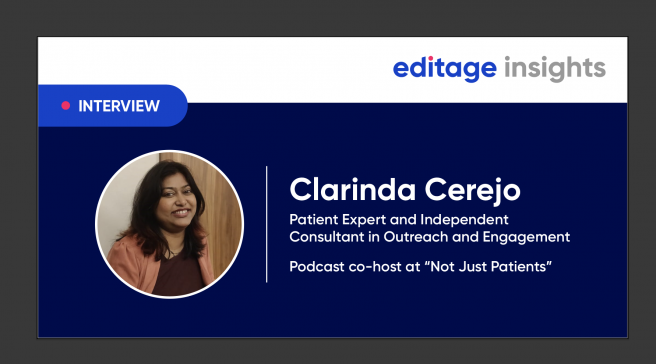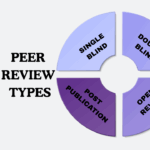How patient engagement can enrich medical studies and literature: Interview with Clarinda Cerejo

The right to health is a recognized fundamental human right. When you think of good-quality healthcare, you might perhaps visualize a patient around whose needs the healthcare infrastructure is designed. Indeed, there’s growing sensitivity to keeping patients’ unique contexts and experiences in mind when developing treatment plans.
Yet, in some ways, this is envisioned as a top-down approach, where a healthcare expert typically determines what the patient needs. Patient involvement does not often extend to a crucial component underpinning healthcare: the planning of medical studies and the reporting of research outcomes—which are the sources of evidence informing healthcare practices.
Just ahead of this year’s World Health Day (April 7), I speak with Clarinda Cerejo, a passionate patient expert, about how engaging patients at these stages can improve the quality of healthcare provided.
About Clarinda: Clarinda is a rare disease patient, a EUPATI-certified Patient Expert, an India Ambassador for The Sumaira Foundation, a Cochrane Consumer Reviewer, and a Stanford-certified Design Thinker.
She serves on the Board of Directors for the Global Patient Advocacy Coalition (GPAC) and on the Management Committee of the Rare Disease Research Network (partnership project between CamRARE and the Patient-Led Research Hub). She consults various organizations, including the World Health Organization, on patient/stakeholder outreach and engagement.
As co-host of the podcast Not Just Patients, Clarinda’s goal is to amplify the patient voice and break barriers to meaningful patient involvement in healthcare.
She is also a former colleague who served as Editor-in-Chief, Editage Insights—during which time, she amassed excellent insights into scholarly publishing from a researcher perspective.
Scholarly communication has traditionally been a transfer of advanced knowledge from subject-matter experts to other subject-matter experts. How can first-hand patient experiences and perspectives add value to medical literature?
Let’s challenge the definition of “subject-matter expert” here. Wouldn’t you agree that someone who lives with the subject matter 24/7 is an expert? For clinical studies, that would be the patient! When you think about it like this, it seems obvious that patients should be more involved in the development of medicines and the associated medical literature.
Unfortunately, for centuries, and even today to a large extent, the patient has been seen as a mere beneficiary who must take what they get from the experts and not ask questions. But patients are asking more questions, reading more medical research papers, and beginning to see their lived experience as a valid and crucial form of expertise.
And the industry is increasingly seeing first-hand the value that patients can bring to medical research and publication, from making sure that research outcomes are more relevant to the end consumer and decision-maker, that is, the patient, to making sure that the research publication is drafted keeping not just other scientists but also patients in mind.
An additional key benefit of patient involvement in medical publications is that it increases the credibility of the publication for the patient community. This means that if medical publications were to include patients as authors, more as the norm than the exception, this could help with public trust in science at large.
Interested in learning how to edit a medical manuscript? Register for our upcoming event: Live edit of a medical manuscript.
Those are great points to think over. How common are patient peer reviews at medical journals? Do patients need special guidance or training to serve as reviewers?
Patient peer review is not as common as it should be, but the trend is moving in the right direction. Cochrane, which publishes systematic reviews on topics that aid medical decision-making, is one of the organizations leading the charge, making “healthcare consumer” (another word for patient) reviews mandatory for all systematic reviews and their published protocols.
Some journals, like the British Medical Journal (BMJ) and the Journal of Patient Experience include patient peer reviews as part of their standard editorial process; others might seek out patient peer reviewers only when the editor feels that a particular submission could especially benefit from a patient’s eye.
Patients as journal editors are less common, but some journals are innovating strategies to change this. For example, the journal Research Involvement and Engagement has a patient as co-Editor-in-Chief.
Typically, the only eligibility criteria for patients are (a) that they are comfortable reading and writing in English, (b) live with or are a caregiver for the condition being addressed in the paper, and (c) have no conflicts of interest in performing the review.
Just as for academics doing their first peer review, there is no formal training as such, but most journals that invite patients as peer reviewers provide guidelines for how to approach reviewing each manuscript section. Additionally, patient peer reviewers might find this “step-by-step guide” published in BMJ Health & Care Informatics useful.
The main challenge for patients starting as peer reviewers is that they may feel underconfident and second-guess their recommendations, or worry that they are asking “stupid questions.” The important thing for them to remember is that all peer reviewers (even scientists) feel this way about performing peer reviews initially, and that they will gain confidence as they perform more reviews.
How can medical/clinical researchers design their studies and plan their publications such that patient perspectives are integrated in the outcomes?
Researchers can set up patient advisory boards or plan to conduct patient interviews to review and refine their study design. These are valid forms of patient involvement and would tick the box.
But I think the best way to involve patients for maximal impact is to include them as study authors. This means involving them from the outset of study design all the way through to publication. This approach can offer perspectives that clinical researchers would never have fathomed but that can significantly improve patient retention and adherence within the study.
Here’s a great story I heard from a patient author who was involved in a multiple sclerosis (MS) study: The study required patients to go through a physical booklet, and the researchers were very proud of the beautifully designed paperback they had produced. When the patient author saw it, he pointed out that the paperback didn’t stay open unless held with two hands, and that MS patients with disabilities might struggle to hold a book in one hand and turn pages with the other. Instead, they needed a spiral bound booklet that could sit open on the table and have pages turned with one hand.
I thought this was a fascinating example of the real value patient authors can bring to research design and implementation.
How can researchers, healthcare professionals, and scholarly publishers make relevant medical information more accessible to patients and their caregivers?
I’m involved in creating plain-language summaries (PLS) for The Sumaira Foundation, a patient organization that advocates for rare autoimmune diseases of the central nervous system. This project has made it clear to me that there remains a huge chasm between medical literature and patient access.
Below I quote from a LinkedIn post I had written to share my insights regarding the existing challenges for patients.
- The body of literature is so extensive that even as a so-called research and publishing expert, I find it difficult to sift through search results and identify truly relevant papers that are conclusive and include a large enough sample size. If this is a challenge for specific rare diseases, I can only imagine the situation for more research-rich disease areas.
- There are no patient-centric quality indicators for research papers! Citations mean nothing to patients.
- It’s been years since PLS have been discussed in medical publishing conferences. Yet very few journals publish PLS with their patient-relevant papers.
- Open access is still a distant dream; a lot of research papers that would be relevant to patients remain paywalled. The only exception I found was Elsevier’s patient access initiative, where patients can email the editorial team to receive a copy of the publication. Still not ideal in terms of barriers removed, but something.
- Once the barriers of knowing the right search terms and where to look, screening masses of papers, identifying relevant ones, and accessing them are crossed, patients would still struggle to make sense of the research and what it means for them.
Clearly, a lot needs to be done.
Could you share some examples of how patient-centric approaches in research and publication have led to positive impact on healthcare?
Patient advocates and people working in patient engagement would have plenty of anecdotes and personal experiences speaking to how patient involvement can influence health policy and treatment access. For example, patient involvement in clinical research can
- improve study design to ensure ease of patient participation, thus improving patient recruitment and retention rates
- help in study design by identifying patient-relevant outcomes, which can in turn can facilitate marketing authorization for new interventions
- improve patient uptake of the interventions arising from such studies, increasing the return on investment for study sponsors
- improve public trust in science, triggering funding for further research into target research areas
However, because of the broad scope and myriad potential approaches to patient involvement, its true impact is hard to measure and impact case studies are hard to come by.
Here are a few literature-backed examples that give a small sense of the potential far-reaching impact of patient involvement.
- In urologic oncology, patient involvement has improved study design and patients’ ability to apply the study results.
- Clinical trial enrolment and retention rates improved in a study on pediatric cerebral palsy when parents were consulted on study design.
- In cystic fibrosis, patients have been paired with healthcare professionals to design interventions that improve treatment adherence in patients.
As someone who has a deep understanding of academia, scholarly publishing, medical communications, and now patient advocacy and outreach, you have gained unique and crucial insights into this subject. What are some key lessons you’ve learned that you’d like to share with researchers?
I’ve seen some common threads in my experience of these diverse areas of work.
In academia and publishing, the open access movement is built on the idea that the people for whom research is intended should have access to research. In medical communications, the movement towards plain-language summaries and visually appealing formats of publications is based on this same goal of widening access to people who will benefit from knowing about these works. Similarly, the patient-engagement movement demands that patients be involved in developing the drugs and tools intended for them.
Patients have more than they show. Beyond their lived experience as patients, they have diverse professional experiences and can bring rich perspectives to any study group.
The new world is a more open and collaborative one. Just as academics are being invited to break the ivory tower, and publishers to banish paywalls, pharma and healthcare professionals are being challenged to shift the power balance and recognize that their expertise is not threatened but in fact augmented by the informed patient.
Those healthcare and medical publication professionals who have already bought into patient involvement have already seen the value and are now evangelists.







